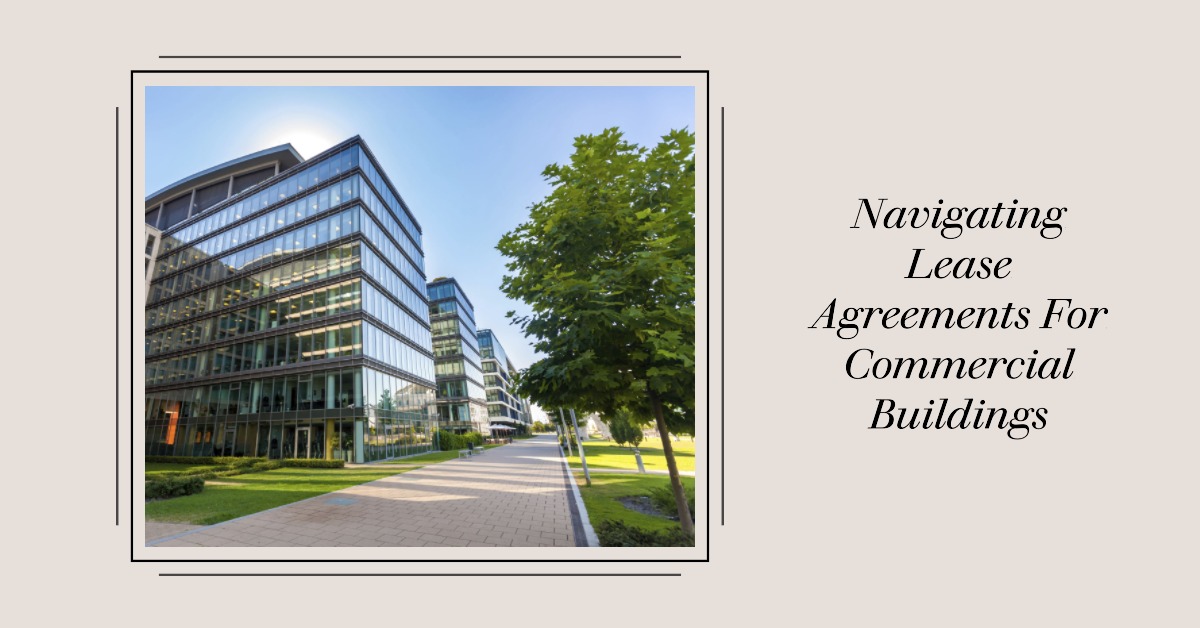As a lease agreement specialist, it’s essential for us to know the ins and outs of commercial building leases. We’re here to help you navigate this complex world, ensuring that you understand all aspects of these contracts before signing on the dotted line.
Commercial building leases are often more intricate than residential ones, so it’s vital to have an expert by your side who can break down each component and make sure you’re getting the best possible deal.
In today’s competitive market, securing the right space for your business is crucial – but don’t be too quick to sign without understanding what you’re committing to!
In this article, we’ll explore common clauses found in commercial leases (such as rent escalation, maintenance responsibilities, and termination rights) and provide valuable tips on how to negotiate favorable terms.
Understanding Common Lease Terms
When entering into a lease agreement for a commercial building, it’s important to understand the common lease terms you may come across. Here are a few key terms to keep in mind:
Rent: This is the amount of money the tenant pays to the landlord for the right to occupy the property.
Security Deposit: This is an upfront payment made by the tenant to the landlord to cover any damages or unpaid rent at the end of the lease term.
Lease Term: This refers to the length of time the lease will be in effect. Commercial leases typically range from one to ten years.
Option to Renew: This is a clause in the lease agreement that gives the tenant the option to renew the lease at the end of the initial lease term.
Maintenance and Repairs: This outlines the responsibilities of the tenant and the landlord when it comes to maintaining and repairing the property.
Subleasing: This is the ability of the tenant to lease out a portion of the space to another tenant.
Termination: This outlines the conditions under which either party can terminate the lease agreement before the end of the lease term.
Utilities: This refers to the payment of utilities such as water, electricity, and gas. It is important to clarify who is responsible for paying these costs.
Common Areas: This refers to shared areas such as hallways, lobbies, and restrooms. The lease agreement should outline who is responsible for maintaining these areas.
By understanding these common lease terms, you can better navigate the lease agreement for a commercial building and ensure that you have a clear understanding of your rights and responsibilities as a tenant. It’s important to carefully review the lease agreement and consult with a legal professional if needed.
Rent Escalation Clauses
Rent escalation clauses are an important aspect of lease agreements to consider during the negotiation process, as they can greatly impact both parties throughout the term of a commercial lease.
Escalation negotiations typically involve discussions on various factors such as index-based adjustments, fixed-rate increases, or market value assessments – all designed to help protect landlords from potentially increasing costs while providing tenants with predictable and manageable rent payments over time.
Understanding the different types of rent escalations and their respective clause benefits is essential for ensuring that both parties reach a mutually beneficial agreement.
It’s crucial for tenants to be aware of any potential future rent increases included in the escalation clauses when entering into a lease agreement. By doing so, they can better prepare and budget for these changes in rental rates, ultimately contributing to business stability and growth.
Landlords should also be diligent about incorporating these provisions clearly within the contract terms, specifying how and when any rent increase will take place. With clear communication between both parties regarding escalation expectations, disputes can be minimized leading to smoother relationships throughout the duration of the lease agreement.
As we move forward in this guide, let us now discuss maintenance and repair responsibilities which play another significant role in commercial leases.
Maintenance And Repair Responsibilities
Having discussed the importance of rent escalation clauses in ensuring a fair and balanced lease agreement, it is now crucial to consider another vital aspect: maintenance and repair responsibilities.
Determining which party – landlord or tenant – bears the responsibility for maintaining and repairing commercial property can greatly impact both parties’ financial obligations and overall satisfaction with the lease arrangement.
To help facilitate this process, here are three essential points to keep in mind when negotiating maintenance and repair responsibilities:
1. Commercial maintenance tips: Regular upkeep is critical to preserving the value and functionality of any commercial space. Establishing clear guidelines on routine tasks such as cleaning, landscaping, pest control, HVAC servicing, and plumbing inspections will benefit both parties by preventing costly issues down the line.
2. Division of responsibilities: Clearly delineate which areas fall under each party’s purview; typically, tenants are responsible for interior spaces while landlords handle structural components like roofs, foundations, exterior walls, and building systems. However, specific arrangements may vary depending on factors such as industry standards or existing agreements between previous occupants.
3. Repair cost allocation: Inevitably, some repairs will be necessary during the course of a lease term. Allocate costs fairly by considering factors like wear-and-tear expectations based on usage patterns or equipment lifespan estimates. Additionally, establish a protocol for handling emergency situations that require immediate attention but may not fall neatly within either party’s designated area of responsibility.
With these considerations in mind when discussing maintenance and repair duties, both landlords and tenants can better understand their respective obligations throughout the leasing period. This understanding promotes smoother operations for all involved parties without unexpected surprises or disputes arising from ambiguous terms regarding property upkeep.
As we continue our exploration into important aspects of commercial lease agreements, let us now turn our focus towards tenant improvement allowances and how they contribute to creating mutually beneficial contracts for everyone involved.
Tenant Improvement Allowances
Tenant Improvement Allowances (TIA) refer to the financial provisions agreed upon between the landlord and tenant, facilitating space customization within the leased premises. These allowances are often a crucial aspect of lease agreement negotiations, as they enable tenants to modify or improve their rented spaces in accordance with their specific needs and preferences.
In order to ensure a fair arrangement for both parties involved, allowance negotiation should be approached diligently by considering factors such as construction costs, market trends, and competitive rates. An essential part of securing an optimal Tenant Improvement Allowance is establishing clear terms and conditions regarding the allocation of funds, scope of work allowed under TIA provisions, and any potential reimbursements for unused allowances.
By defining these aspects in detail during negotiations, both landlords and tenants can minimize misunderstandings that may arise over improvement projects undertaken throughout the duration of the lease term. As we move forward into discussing termination rights and penalties associated with commercial leases, it is important to bear in mind how TIAs can impact those considerations as well.
Termination Rights And Penalties
All good things must come to an end, and so too may your lease agreement. Termination rights and penalties are a crucial aspect of any commercial lease agreement that should not be overlooked.
Early termination refers to the right of either party, tenant or landlord, to terminate the lease before its natural expiration date under certain conditions stipulated in the contract. It is important for tenants to negotiate these terms carefully since they can significantly impact their ability to respond to changing business needs.
When negotiating termination rights and penalties, it’s essential for both parties to establish clear guidelines on what circumstances warrant early termination and how penalties will be calculated. As a tenant, you might consider including clauses that allow for termination without penalty if the rented space becomes unusable due to damage, substantial changes made by the landlord affecting your operations, or other unforeseen events beyond your control.
Landlords may also seek penalty negotiation provisions if they believe there’s potential financial loss from an early exit by the tenant. Thus, finding a balance between flexibility and protection is key when discussing this part of the lease agreement.
With this understanding in hand, we now turn our attention towards effective negotiation strategies aimed at securing favorable leasing terms without further ado.
Negotiation Strategies For Favorable Terms
As a lease agreement specialist, it’s crucial to understand the importance of negotiation strategies when aiming for favorable terms in commercial building leases.
One key factor to consider is securing flexible leases that cater to your business needs while also providing room for growth and adaptation. This involves working closely with landlords or property managers to establish clear communication channels, ensuring both parties are aware of each other’s expectations and requirements.
By addressing potential issues early on, you’ll be better equipped to negotiate favorable lease terms such as rent abatements, tenant improvement allowances, and options for expansion.
Another essential aspect of achieving advantageous lease conditions revolves around renewal strategies.
As tenants approach the end of their initial lease term, they may have the option to renew their contract under different circumstances or pursue alternative spaces altogether.
It’s important to evaluate market trends and assess your organization’s evolving needs during this time, allowing you to make informed decisions about whether extending your current lease makes sense financially and logistically.
Furthermore, maintaining an open dialogue with your landlord throughout this process will enable renegotiation opportunities based on the latest industry data and personal preferences – ultimately positioning yourself more favorably within the competitive landscape of commercial real estate leasing agreements.
Conclusion
In conclusion, navigating lease agreements can feel like trying to find your way through a maze with hidden traps and pitfalls.
However, by understanding common lease terms, rent escalation clauses, maintenance responsibilities, tenant improvement allowances, termination rights, and negotiation strategies, you’ll be better equipped to reach the ultimate prize: a favorable commercial lease agreement.
Remember that success lies in the details.
As a seasoned lease agreement specialist once said – ‘Knowledge is power when it comes to leasing.’
Equip yourself with information and expertise so you can confidently navigate the complex world of commercial leases and secure the best possible deal for your business.

